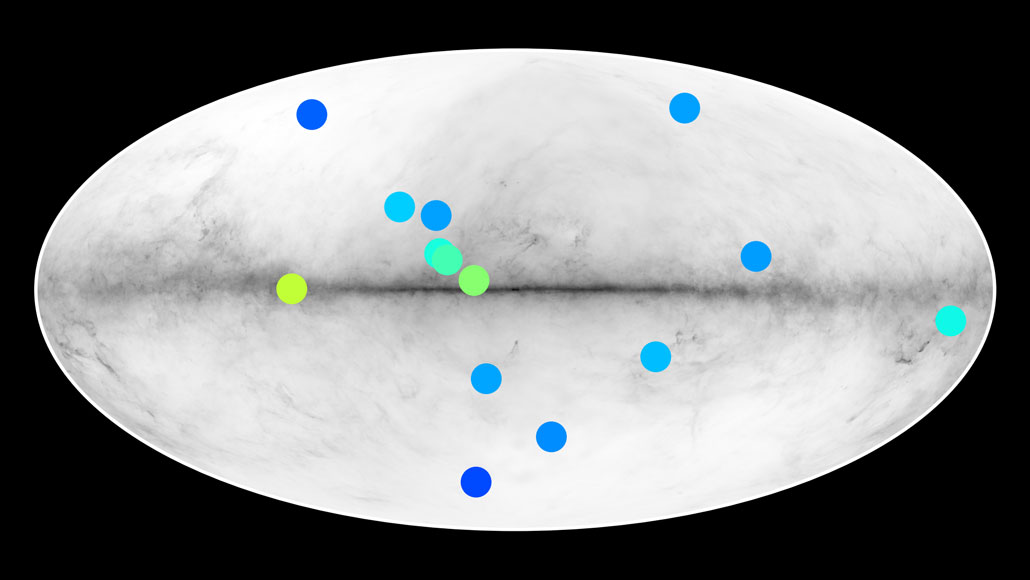Stars made of antimatter could lurk in our galaxy
If such antistars exist, that would mean some antimatter survived to the present day

Fourteen celestial sources of gamma rays look like they could be stars made of antimatter. Each potential antistar is a colored dot on this map of the Milky Way. Greener dots are brighter sources; bluer dots are dimmer.
Simon Dupourqué/IRAP
All known stars are made of ordinary matter. But astronomers haven’t completely ruled out that some could be made of antimatter.
Antimatter is the oppositely charged alter-ego of normal matter. For instance, electrons have antimatter twins called positrons. Where electrons have negative electric charge, positrons have positive charge. Physicists think the universe was born with equal amounts of matter and antimatter. Now the cosmos appears to have almost no antimatter.
Space-station data have recently cast doubt on this idea of a practically antimatter-free universe. One instrument might have seen bits of antihelium atoms in space. Those observations have to be confirmed. But if they are, that antimatter could have been shed by antimatter stars. That is, antistars.
Intrigued by this idea, some researchers went hunting for potential antistars. The team knew that matter and antimatter annihilate each other when they meet. That could happen when normal matter from interstellar space falls onto an antistar. This type of particle annihilation gives off gamma rays with certain wavelengths. So the team looked for those wavelengths in data from the Fermi Gamma-ray Space Telescope.
And they found them.
Fourteen spots in the sky gave off the gamma rays expected from matter-antimatter annihilation events. Those spots did not look like other known gamma-ray sources — such as spinning neutron stars or black holes. That was further evidence that the sources could be antistars. Researchers reported their find online April 20 in Physical Review D.
Rare — or possibly hiding?
The team then estimated how many antistars could exist near our solar system. Those estimates depended on where antistars would most likely be found, if they truly existed.
Any in the disk of our galaxy would be surrounded by lots of normal matter. That could cause them to emit lots of gamma rays. So they should be easy to spot. But the researchers only found 14 candidates.
That implies that antistars are rare. How rare? Perhaps only one antistar would exist for every 400,000 normal stars.
Antistars could exist, however, outside the Milky Way’s disk. There, they would have less chance to interact with normal matter. They also should emit fewer gamma rays in this more isolated environment. And that would make them harder to find. But in that scenario, one antistar could lurk among every 10 normal stars.
Antistars are still only hypothetical. In fact, proving any object is an antistar could be nearly impossible. Why? Because antistars are expected to look almost identical to normal stars, explains Simon Dupourqué. He’s an astrophysicist in Toulouse, France. He works at the Institute of Research in Astrophysics and Planetology.
It would be much easier to prove the candidates found so far are not antistars, he says. Astronomers could watch how gamma rays from the candidates change over time. Those changes might hint at whether these objects are really spinning neutron stars. Other types of radiation from the objects might point to their actually being black holes.
If antistars exist, “that would be a major blow” for our understanding of the universe. So concludes Pierre Salati, who wasn’t involved in the work. This astrophysicist works at the Annecy-le-Vieux Laboratory of Theoretical Physics in France. Seeing antistars would mean that not all of the universe’s antimatter was lost. Instead, some would have survived in isolated pockets of space.
But antistars probably could not make up for all the universe’s missing antimatter. At least, that’s what Julian Heeck thinks. A physicist at the University of Virginia in Charlottesville, he too did not take part in the study. And, he adds, “you would still need an explanation for why matter overall dominates over antimatter.”







